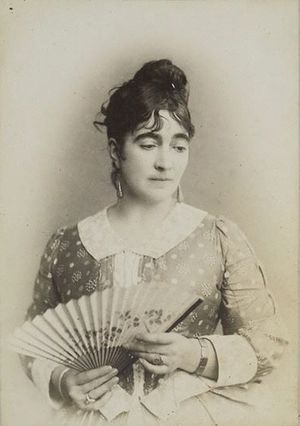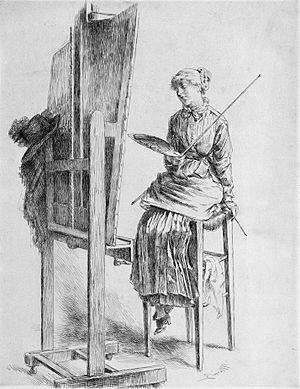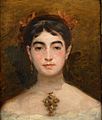Marie Bracquemond facts for kids
Quick facts for kids
Marie Bracquemond
|
|
|---|---|

c. 1886
|
|
| Born |
Marie Quivoron
1 December 1840 Argenton-en-Landunvez, near Brest, Finistère, France
|
| Died | 17 January 1916 (aged 75) |
| Nationality | French |
| Known for | Painting |
| Movement | Impressionism |
| Spouse(s) | |
Marie Bracquemond (born December 1, 1840 – died January 17, 1916) was a talented French Impressionist artist. She was one of only four important women artists in the Impressionist movement. The others were Mary Cassatt, Berthe Morisot, and Eva Gonzalès.
Marie started drawing when she was a child. She even showed her art at the famous Paris Salon when she was still a teenager. She didn't have formal art school training. However, she learned from famous artists like Jean-Auguste-Dominique Ingres and received advice from Paul Gauguin.
She married Félix Bracquemond, a well-known printmaker. He helped make Japanese art popular in France. Marie and Félix also created ceramic art together for a company called Haviland & Co.. Sadly, Marie's art is sometimes left out of art books. This is often because her husband, Félix, was very critical of her work. He was even jealous of her talent. Their son, Pierre, said that Félix would not show Marie's paintings to visitors.
Marie Bracquemond showed her art in three major Impressionist exhibitions. These were in 1879, 1880, and 1889. She created at least 157 artworks during her life. But only 31 of these can be found today. The rest are in private collections. Her only solo art shows happened after she died. Some of her most famous paintings include The Lady in White (1880) and Afternoon Tea (1880).
Contents
Early Life and Art Training
Marie Anne Caroline Quivoron was born on December 1, 1840. Her birthplace was Argenton-en-Landunvez, near Brest, in Brittany, France. Her childhood was different from other famous female Impressionists. Her parents had an unhappy arranged marriage. Her mother left her father and moved often, living in different parts of France and even Switzerland. Marie had one sister, Louise, born in 1849.
As a teenager, Marie began painting lessons. Her teacher was M. Auguste Vassor, an old painter who fixed artworks. In 1857, she sent a painting to the Paris Salon, a big art show. It showed her mother, sister, and teacher. The painting was accepted! After this, she met the famous painter Jean Auguste Dominique Ingres. He gave her advice and introduced her to his students.
A critic named Philippe Burty called her "one of the most intelligent pupils in Ingres' studio." But Marie found Ingres very strict. She wrote that he "doubted the courage and perseverance of a woman in the field of painting." He thought women should only paint flowers, fruits, still life, or portraits.
Later, Marie left Ingres' studio. She started getting paid to create art. One important job was for Empress Eugenie. She asked Marie to paint Miguel de Cervantes in prison. This painting was well-liked. So, Marie was then asked to copy important artworks in the Louvre museum.
Family Life and Challenges
While copying paintings in the Louvre, Marie met Félix Bracquemond. He fell in love with her. They became engaged and married on August 5, 1869. Marie's mother did not approve of the marriage. In 1870, their only child, Pierre, was born. Marie's health became weaker after Pierre's birth. This was partly because of the Franco-Prussian War and the Paris Commune, which made good medical care hard to find.
Most of what we know about Marie's personal life comes from a book written by her son, Pierre. It was called The Life of Félix and Marie Bracquemond.
Marie's Artistic Journey

Félix and Marie Bracquemond worked together at the Haviland studio in Auteuil. Félix was the art director there. Marie designed plates for dinner sets. She also made large tile panels called Les Muses des arts (The Muses of the Arts). These were shown at the Universal Exhibition of 1878. Sadly, this artwork is now lost.
Marie's paintings were regularly accepted at the Paris Salon starting in 1864. Her husband tried to teach her etching, a type of printmaking. She made nine etchings that were shown in London in 1890. Félix also showed her new art methods and introduced her to artists he admired. She especially liked the Belgian painter Alfred Stevens.
Between 1887 and 1890, Marie's art style began to change. She was influenced by the Impressionists. Her paintings became larger and her colors brighter. She started painting outdoors, a style known as plein air. Her husband disliked this, but Claude Monet and Degas became her guides.
Many of her best-known works were painted outside. She often painted in her garden at Sèvres. One of her last paintings was The Artist's Son and Sister in the Garden at Sèvres. Marie showed her art in the Impressionist exhibitions of 1879, 1880, and 1886. Some of her drawings were published in a magazine called La Vie Moderne.
In 1886, Félix Bracquemond introduced Marie to Paul Gauguin. Gauguin had a big impact on Marie. He taught her how to prepare her canvas to get the strong colors she wanted.
Unlike many Impressionist artists, Marie planned her artworks carefully. Even though her paintings look natural, she made many sketches and drawings first. Marie Bracquemond's art is thought to be very true to the ideas of Impressionism. This is true even though her famous husband often overshadowed her.
According to their son Pierre, Félix Bracquemond was often mean to his wife. He would reject her ideas about his art. He also refused to show her paintings to visitors. Pierre wrote that his father "seldom showed her work to their friends." He also said that Félix would call her ambition "incurable vanity." In 1890, Marie Bracquemond stopped painting. She was tired of the arguments at home and the lack of interest in her art. She only painted a few private works after that.
Even when she wasn't actively painting, Marie always defended Impressionism. When her husband criticized her art, she said, "Impressionism has produced... a very useful way of looking at things. It is as though all at once a window opens and the sun and air enter your house in torrents."
Death and Lasting Impact
Marie Bracquemond died in Paris on January 17, 1916. An art critic named Arsène Alexandre wrote about her in the newspaper Le Figaro. He said that Bracquemond "was one of those artists ignored." He believed that future generations would be surprised by her rare talent. He called her an "exquisite painter" whose character was "sensitive, proud and an almost excessive modesty."
In 1928, art historian Henri Focillon called Bracquemond one of the "three great ladies" of Impressionism. The other two were Berthe Morisot and Mary Cassatt. In the 1970s, people started paying more attention to women artists in the Impressionist movement. This led to new interest in Marie Bracquemond's forgotten art. In the 1980s, art historian Tamar Garb wrote a book called Women Impressionists. This book helped bring Marie Bracquemond's work to light. Bracquemond's art was also included in the "Women in Paris 1850-1900" exhibit in 2018.
Her Artworks
There isn't a complete list of all of Marie Bracquemond's artworks. The list below is from an exhibition catalog from 1919. Marie Bracquemond created at least 81 paintings, 34 watercolors, 23 drawings, and nine etchings. This list does not include her ceramic works. At least two of her works are believed to be lost. These include the ceramic panel The Muses (1878) and the painting The Swallow (1880).
- Selected paintings
- Selected watercolors
- Selected Drawings
- Selected etchings
- Selected ceramics
Selected Exhibitions
| Selected Marie Bracquemond Exhibitions - Solo | Date |
| Paris, Bernheim-Jeune. Catalogue of paintings, watercolors, drawings and etchings by Marie Bracquemond. | 1919 |
| Paris, Bernheim-Jeune. | 1962 |
| Group exhibitions | |
| Mortagne, Musée de Mortagne. Félix Bracquemond, 1833-1914: engravings, drawings, ceramics. Marie Bracquemond, 1841-1916. paintings. Also shown in Chartres. | 1972, May-September |
| Ann Arbor, University of Michigan, Museum of Art. The Crisis of Impressionism, 1878-1882.
This show included works by Marie and Félix Bracquemond, Cassatt, and Morisot, among many other Impressionist artists. |
1979-80, November 2 - January 6 |
| Paris, Musée d’Orsay. Women, art and power (Femmes, art et pouvoir) | 2019-20, September 11 - January 20 |
See also
- List of women artists exhibited at the 1893 World's Columbian Exposition
- Society of Modern Women Artists
























